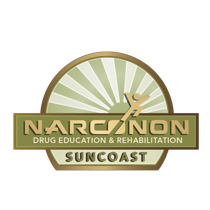By: Kelly Stark
Percocet is a common drug, but what is it? Suncoast Rehab explains all about Percocet in easy-to-understand terms.
Percocet is Oxycodone (main ingredient in OxyContin) and acetaminophen (commonly known as Tylenol), acetaminophen boosts the effects of Oxycodone when taken together, making the Oxycodone a more potent pain reliever.
Oxycodone is a very strong opioid, meaning partially partially synthetic, used as a analgesic (which means “pain reliever”) for patients in moderate to severe pain after surgery or to combat chronic pain in patients. Acetaminophen is a weaker analgesic and fever reducer.
The common side effects of Percocet are constipation, dizziness, drowsiness, flushing, light-headedness, nausea and vomiting.
There are also possible serious, sometimes allergic, reactions to Percocet. These include respiratory depression, apnea (the absence of breathing), respiratory arrest, circulatory depression, hypotension (decreased or lowered blood pressure), and shock.
Psychological side effects are also an issue with Percocet. These would include dependence on the drug itself, abuse of the drug (or others), insomnia, confusion, anxiety, agitation, depressed level of consciousness, nervousness, hallucinations, somnolence (severe drowsiness), depression and suicide.
Percocet works by attaching to pain receptors in brain and blocking “pain” from being registered in the brain. Eventually, since awareness of pain is a survival mechanism of the body, the brain adjusts its pain registration, usually meaning the user increases the dosage continuously to maintain that pain relief. Because the body is continuously becoming “used to” and dependent on the pills, this increased dosage can escalate to a dangerously high level.
The “high” Percocet gives the user, and especially a drug addict, is a sense of loss of surroundings. They experience a semi-conscious type of high. When the user first takes the pill, the high is the strongest. Usually the addict attempts to chase that first high, without success as the body has already begun to adjust to the drug, the brain working ways to register any pain despite the drug.
Percocet is a schedule II drug which means it has a high potential for abuse which may lead to severe psychological or physical dependence.
Other schedule II drugs include heroin, methamphetamines, cocaine, and opium.
Abrupt discontinuation of Percocet can lead to intense withdrawal symptoms in prolonged users. Then, when someone wants to get help and does succeed in getting off the pills, there are still drug residuals in the body that can cause physical cravings for the drugs. There is a detoxification step at the Suncoast drug rehabilitation center that can actually remove these drug residuals thus reducing or removing completely the cravings for the drugs.
www.drugs.com
www.rxlist.com
www.drugstrategies.org
www.prescriptiondrugabuse.org
www.deadiversion.usdoj.gov
New Life Detoxification Program
